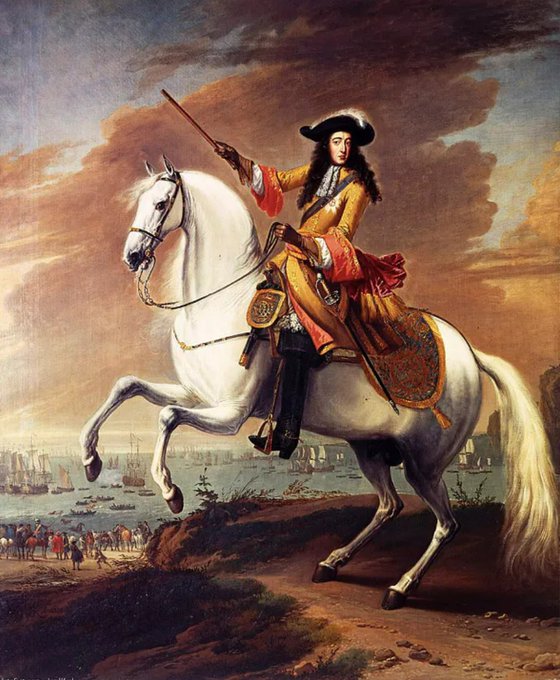Prince William III of Orange lands with a Dutch fleet at Brixham to challenge the rule of King James II of England (James VII of Scotland). (1688 CE).

William of Orange was born on 4 November 1650 in Binnenhof Palace, The Hague. His father was William II of Orange and his mother Mary Stuart, the daughter of Charles I of England (r. 1625-1649). William’s father died before he was even born, and he lost his mother when he was just 10 years old. Both parents had succumbed to smallpox. Consequently, William became Prince of Orange immediately, a name which derives from the small principality near Avignon in southern France.

The Dutch royal house was in decline, there were powerful anti-royal voices in the Netherlands, and the country was under threat from France, but William’s strength of character and ties with England would be his salvation. The prince visited England in 1670, he was presented with two honorary university degrees, and he had an audience with his uncle Charles II of England (r. 1660-1685). The English king’s family relations did not prevent him from going to war with the Netherlands in 1672. During this conflict, William became Captain and Admiral-General of the combined Dutch armed forces. In 1675, the prince was wounded in the arm fighting the French, and that after surviving a bout of smallpox the year before.
The Glorious Revolution
William’s main concern for the Netherlands was that this collection of states was under an ever-more serious threat from Catholic France, which was expanding its territory across the European continent. The Dutch navy could not fight both England and France together. This was one of the reasons William married Princess Mary, the daughter of (future) James II at Whitehall on 4 November 1677. Mary was considered something of a beauty, while William was short, hunched, had a hooked nose and black teeth, and his character was no improvement, being taciturn and humourless. Despite the physical disparity, the couple did eventually build a strong bond, although William kept at least one mistress (Elizabeth Villiers), and there were rumours that his taste ran to young men. The diplomatic significance of the marriage seemed to have its desired effect when Louis XIV of France (r. 1643-1715) signed a peace treaty with the Netherlands in 1678.
WILLIAM OF ORANGE WAS THE GRANDSON OF CHARLES I OF ENGLAND & THE SON-IN-LAW OF JAMES II.
William was a Calvinist Protestant, and Mary had been brought up a Protestant on the insistence of the English Parliament, which feared her Catholic father James (he had converted in 1668) had plans to reinstate Catholicism as the state religion when he succeeded his elder brother Charles II of England. Indeed, when James became king in 1665, he began to place Catholics in prominent public positions and insisted certain Catholic practices be tolerated. Further, the king was an authoritarian who ignored certain laws and who was biased in the application of others when it suited. James even dismissed Parliament in November 1685, and that body was never to be recalled while he sat on the throne. The final straw came when James finally had a son, born on 10 June 1688: James Francis Edward. The king was Catholic, the queen, Mary of Modena (d. 1718), was Catholic, and now, surely, the heir would be Catholic.
When in June 1688 prominent Protestant figures in England invited William of Orange to invade and become king, he gladly accepted. William was the grandson of Charles I of England and the son-in-law of James II, he was Protestant, and the Netherlands could be a very useful ally with its powerful navy and trade connections. The Prince of Orange was already planning an invasion even without the invitation, and he said he had merely been waiting for a favourable “Protestant wind”. The ever-present threat from France had allowed William to disguise his build-up of 60 warships as a purely defensive precaution.
William would have been encouraged by two rebellions early on in James II’s reign: the Argyll Rebellion in Scotland in May 1685 and the Monmouth Rebellion in the southwest of England in June-July of the same year. Both were relatively minor affairs and easily quashed when their respective leaders were caught and executed, but they did show William he would gain at least some support for a regime change back to a Protestant monarchy. Support and public celebrations of the acquittal of several prominent Protestant bishops whom James had hoped to imprison was another indication that the kingdom was far from unified in its support of the status quo.
Invasion
William’s first attempt to reach England by sea was scuppered by stormy weather, but he persisted and landed with an army of 15-21,000 men in Devon on 5 November 1688. The army was an experienced fighting force and made up of Dutch, English, Scots, Danes, Huguenots, and even a contingent from Suriname. The prince also took a printing press so that he might more easily spread pro-Protestant propaganda. When he landed at Brixham, William reassured the Englishmen he met that “I come to do you goot. I am here for all your goots” (Cavendish, 338).
William marched slowly east towards London through unfavourable weather. Meanwhile, James was left isolated, deserted by former supporters like John Churchill and even his own daughter Anne. The queen left England for the safety of France in December. James suffered more important desertions amongst his top army staff, and there were immediate uprisings in favour of William in Cheshire, Yorkshire, and Nottinghamshire. Then after being hit with a bizarre series of nosebleeds, the king decided to abandon the battlefield and follow his wife. The king may have been suffering a mental breakdown at this point as he became utterly convinced he was destined to suffer the same terrible fate as his father. Queen Mary made it across the Channel, but the king did not, despite his disguise as a woman. He was spotted by fishermen and taken captive in Kent. William was by now in London, and he decided the best thing to do with his rival and father-in-law was to allow him to leave for France as he had wished. William had achieved the remarkable feat of heading the first successful invasion of England since his namesake William the Conqueror (r. 1066-1087) in 1066.
